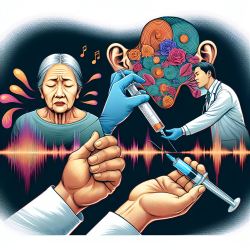Introduction
Vocal aging is a natural process that affects the biomechanical and neural properties of the larynx, leading to changes in voice quality over time. For practitioners working with voice disorders, understanding the interaction between vocal aging and treatment efficacy is crucial. This blog post explores the findings from a study on adductor spasmodic dysphonia (ADSD) and the response to botulinum toxin (BT) injections, providing insights into how age influences treatment outcomes.
Adductor Spasmodic Dysphonia and Treatment
ADSD is a voice disorder characterized by involuntary spasms of the vocal folds, resulting in a strained and effortful voice. The standard treatment involves BT injections, which temporarily paralyze the muscles, reducing spasms and improving voice quality. However, recent research suggests that the effectiveness of BT injections may diminish with age.
Research Findings
The study, conducted by Cannito et al. (2008), analyzed the response of 42 patients with ADSD to BT injections. The results indicated a significantly reduced positive response in older patients compared to their younger counterparts. Acoustic spectrography and perceptual judgments by expert listeners highlighted that older patients experienced less improvement in voice quality post-treatment.
Implications for Practitioners
These findings underscore the importance of considering age as a factor when planning treatment for ADSD. Practitioners should be aware that older patients may require additional therapeutic interventions or adjusted expectations for BT treatment outcomes. Here are some strategies to enhance treatment efficacy for older patients:
- Customized Treatment Plans: Tailor treatment plans to accommodate the unique needs of older patients, considering their overall health and vocal history.
- Multimodal Therapy: Combine BT injections with behavioral voice therapy to maximize treatment benefits.
- Regular Monitoring: Conduct regular assessments to monitor changes in voice quality and adjust treatment as needed.
- Patient Education: Educate patients about the potential impact of aging on treatment outcomes and set realistic expectations.
Encouraging Further Research
While this study provides valuable insights, further research is needed to explore the underlying mechanisms that contribute to the diminished response in older patients. Investigating factors such as neuromuscular changes, vocal fold elasticity, and the role of comorbid conditions could lead to more effective treatment strategies.
Conclusion
Understanding the interaction between vocal aging and treatment efficacy is essential for improving outcomes for patients with ADSD. By incorporating these insights into clinical practice, practitioners can enhance their ability to provide effective, individualized care for patients across the lifespan.
To read the original research paper, please follow this link: Vocal aging and adductor spasmodic dysphonia: Response to botulinum toxin injection.










